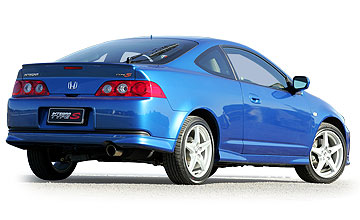BY BYRON MATHIOUDAKIS | 7th Oct 2005

There was the Integra as well as Honda’s CRX and Prelude, the Hyundai S Coupe, Nissan 200SX, Mazda MX-6, Ford Probe, Eunos 30X, Holden Calibra, Nissan NXR, Toyota MR2 and Paseo and, of course the car that kicked off the craze in the early '70s, a Toyota Celica.
Today though it's just Integra, Celica and the Hyundai Tiburon. All others are history.
Not coincidentally, the number of compact urban 4WDs (SUVs wasn’t a term used back then) has gone from about three in ’95 (Toyota RAV4, Suzuki Vitara, Daihatsu Feroza) to around a dozen. Hmmm...
And "premium" small cars (VW Golf, Audi A3, BMW 1 Series and Compact and Mercedes Sport Coupe) have also risen to the fore.
It’s not too hard to see where all the coupe buyers have gone then.
So the Integra, it seems, is part of a breed that looks like it’s going the way of the dinosaurs. Or Michael Jackson’s pop music career.
But that’s a shame because, on the whole, the Integra Type S is a bit of a Thriller.
Not, I should add, in the way the sensational 1999 Type R was, with its hand-built engine, honed chassis and stripped weight, but in the way it delivers its impressive performance to the front wheels with engaging verve.
The Type S is like a marriage between the superseded 2001 Type R (now gone), with the luxury and comfort of, say, the Integra SE. Yet the former is still the dominant (Billie) gene here.
The late 2004 facelift saw a number of changes to the Integra range.
They included new headlights, bumpers, air-dam and tail-lights, a reduced ride height, suspension geometry changes, a bigger anti-roll bar, new springs and dampers and redesigned seats.
The Type S’s 2.0-litre engine’s intake duct grew 10 per cent, the six-speed manual’s final drive ratio was lowered and now benefited from improved synchromesh, the suspension was further firmed up, the brakes were improved and a bigger wheel/tyre package was incorporated
It was all done in the name of progressing the way the sportier Integra drives.
So now, as then, on the front-wheel drive Civic-derived platform (meaning compact strut-style front suspension and wishbones out back) it impresses with its surprising maturity and unruffled poise.
A quick-ratio steering is light but talkative, directing a chassis of crisp, quick handling capabilities and genuinely grippy roadholding.
Curves are carved up cleanly with minimum fuss while strong, confidence-inspiring brakes (aided by anti-lock with electronic brake-force distribution) bite at will.
The ride, on the other hand, is very firm indeed, and will jar on certain surfaces, but there’s still enough pliancy there for some degree of everyday comfort and normality.
Power comes courtesy of a muscular 154kW 2.0-litre four-cylinder engine. Thanks to the low-torque/high rev abilities of i-VTEC, performance is smooth, sweet and very strong, coming on like a tidal wave really once the tacho needle swings up.
There's also very little inertia to this drivetrain, translating to startlingly swift progress that's aided by a superbly slick and short-shifting six-speed manual – certainly one of the best that’s ever been mated to a front-driver.
With 194Nm of torque peaking at a heavenly 7000rpm on its way to 8400rpm (the old R was 192Nm at 6000) there's plenty of punch down-low while the mid-range wallop once that VTEC screamer is singing to its 7000rpm power top is tremendous.
Meanwhile the occupants are enveloped by the sheer mechanical cacophony of this mechanical musical, feeling it through the pedals and seats as well as the ears. It’s an electric experience that engages as easily as it eggs you on for more. If you’re not in the mood though then it can get a bit tiring.
The rest of the Integra Type S interior is just along for the ride, really.
Not much has changed really since the 2001 update, so there’s space aplenty for the lucky front occupants.
Low and leather clad, the front pews are suitably sporty, although they could definitely do with more side support. At least they don’t pinch your love handles like the old Type R.
Out back it isn't too bad either although – infuriatingly – neither front seat will return to its original position once it’s flipped forward. How long have you been building coupes again, Honda?
Rear vision is pretty poor though while cargo space is super thanks to a split-fold rear bench, deep flat floor and huge hatch door.
The previous edition’s almost German austerity (and quality) about the dashboard remains. Still, it’s ergonomically faultless.
The uniquely dished instrument dials are still nice and novel, as are the circular vents, climate controls and spunky steering wheel.
For your $42,990 there’s dual airbags, climate control air-conditioning, an alarm, keyless entry, power windows, a laughably chintzy CD player, sunroof, leather trim and stylish 17-inch alloy wheels.
But no cruise control is a cruel omission in a sizzling grand touring open-road coupe like this.
Not that there’s too many of them left at this price point.
The sporty coupe as we knew it is falling to more lifestyle orientated hatchbacks and SUVs that – Golf GTi and 120i aside – can’t deliver the driving experience of this Integra.
Yet the VW and BMW can’t deliver the stylistic signature of a swoopy two-door.
Here’s hoping that the segment that Celica made popular (but the 1969 Ford Capri pioneered, actually) keeps seeing little rockets like the fabulous Integra Type S.